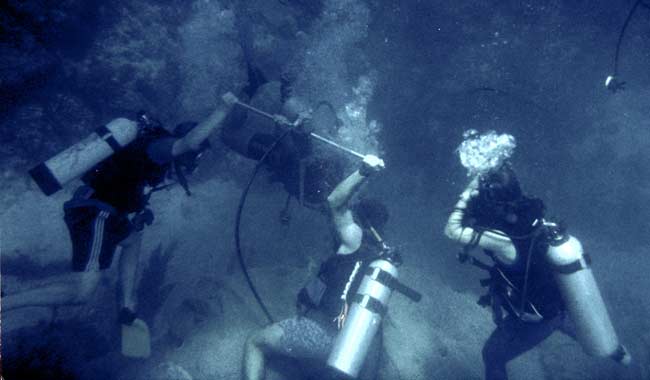Corals Show Recent Hurricane Spike Might Be the Norm

The recent upsurge in the number of major Atlantic hurricanes may be the rule and not the exception, a new report suggests. The findings of this and other studies call into question recent assertions that global warming is behind the burst in hurricane activity seen since the mid-90s.
Between 1995 and 2005, an average of 4.1 major hurricanes (Category 3 or higher) were spawned over the Atlantic each year. But in the three decades before that, only 1.5 major hurricanes formed each year, according to National Oceanic and Atmospheric Administration records.
Some scientists have attributed the burst in hurricane activity over the past decade to rising sea surface temperatures caused by global warming, as warm waters can feed a growing storm.
Others have connected the rise to weaker wind shear, which lops off the top of a developing storm and prevents it from intensifying. (El Niño conditions over the Pacific Ocean are believed to have increased wind shear in 2006, preventing the development of storms and busting that season’s forecast.)
With both of these factors influencing a hurricane’s development, the big question becomes which one will win out in a warming world?
Corals and sediment cores
To answer that question, scientists like to look at hurricane activity in the past, which can tell them whether or not recent activity is an abnormal spike in the record. But reliable observations of hurricane activity over the Atlantic only go back to 1944, so scientists have to turn to other indicators.
Get the world’s most fascinating discoveries delivered straight to your inbox.
One team of scientists examined Caribbean corals and the abundances of a particular plankton to see how hurricane activity, which affects both groups, changed over the past 270 years.
Some corals have the ability to bioluminesce, or produce and emit light on their own. As corals grow, they exhibit features called banding that can reflect changes in the intensity of this luminescence. The intensity is affected by the amount of precipitation in the area, which in turn is influenced by wind shear—the higher the wind shear, the less precipitation.
The abundance of the plankton species Globigerina bulloides is also affected by wind shear, as stronger winds enhance ocean upwelling, providing the critters with more nutrients.
The researchers compiled data of these coral proxies, or stand-ins, for direct hurricane data, and reconstructed wind shear and sea surface temperature records for the past 270 years, giving them an idea of what hurricane activity might have been like.
They found that the downward trend in the number of hurricanes from the 1940s to the 1970s was replicated by the reconstruction and is attributable to greater wind shear, which likely stifled hurricane development.
The scientists also used the reconstruction to compare the current upswing in hurricanes to past active phases and found that it was “unexceptional.”
In the future
So though sea surface temperatures have been rising with global warming over the past century, the authors of the new study, detailed in the June 7 issue of the journal Nature, say that higher wind shear won out over any fuel hurricanes would have received from the water during the lull from the 40s to the 70s.
But in the future, if wind shear decreases (which could happen if there were fewer El Niño events), and sea surface temperatures continue to rise, storms could have longer lifetimes, form more often or become more intense, the authors concluded in their paper.
Other studies, including another recent Nature study that examined sediment cores from a Puerto Rican lake, have put together these past hurricane records from proxy data and concluded that wind shear may be more important than the ocean’s temperature in influencing hurricane activity.
But these studies are limited to very local areas, said climatologist James Elsner in an editorial accompanying the new study, so their results are not necessarily applicable to the Atlantic at large.
Elsner says more records are needed to piece together the history of hurricane activity in the Atlantic and determine just which factors make hurricanes behave the way they do and which will matter most in the coming decades.
- 2007 Hurricane Guide
- First-Ever 5,000-Year Record of Hurricanes Compiled
- Images: Hurricanes from Above

Andrea Thompson is an associate editor at Scientific American, where she covers sustainability, energy and the environment. Prior to that, she was a senior writer covering climate science at Climate Central and a reporter and editor at Live Science, where she primarily covered Earth science and the environment. She holds a graduate degree in science health and environmental reporting from New York University, as well as a bachelor of science and and masters of science in atmospheric chemistry from the Georgia Institute of Technology.


